Hiring the right Business Analyst can significantly impact your organization's success and efficiency. Asking the right interview questions is key to identifying candidates with the necessary skills, experience, and problem-solving abilities.
This blog post provides a comprehensive list of Business Analyst interview questions, covering various aspects of the role. From basic questions for junior candidates to advanced queries for seasoned professionals, we've got you covered with over 70 carefully curated questions across different categories.
Use these questions to thoroughly evaluate candidates and make informed hiring decisions. Consider complementing your interview process with a pre-employment Business Analyst assessment to ensure a well-rounded evaluation of potential hires.
Table of contents
10 basic Business Analyst interview questions and answers to assess applicants
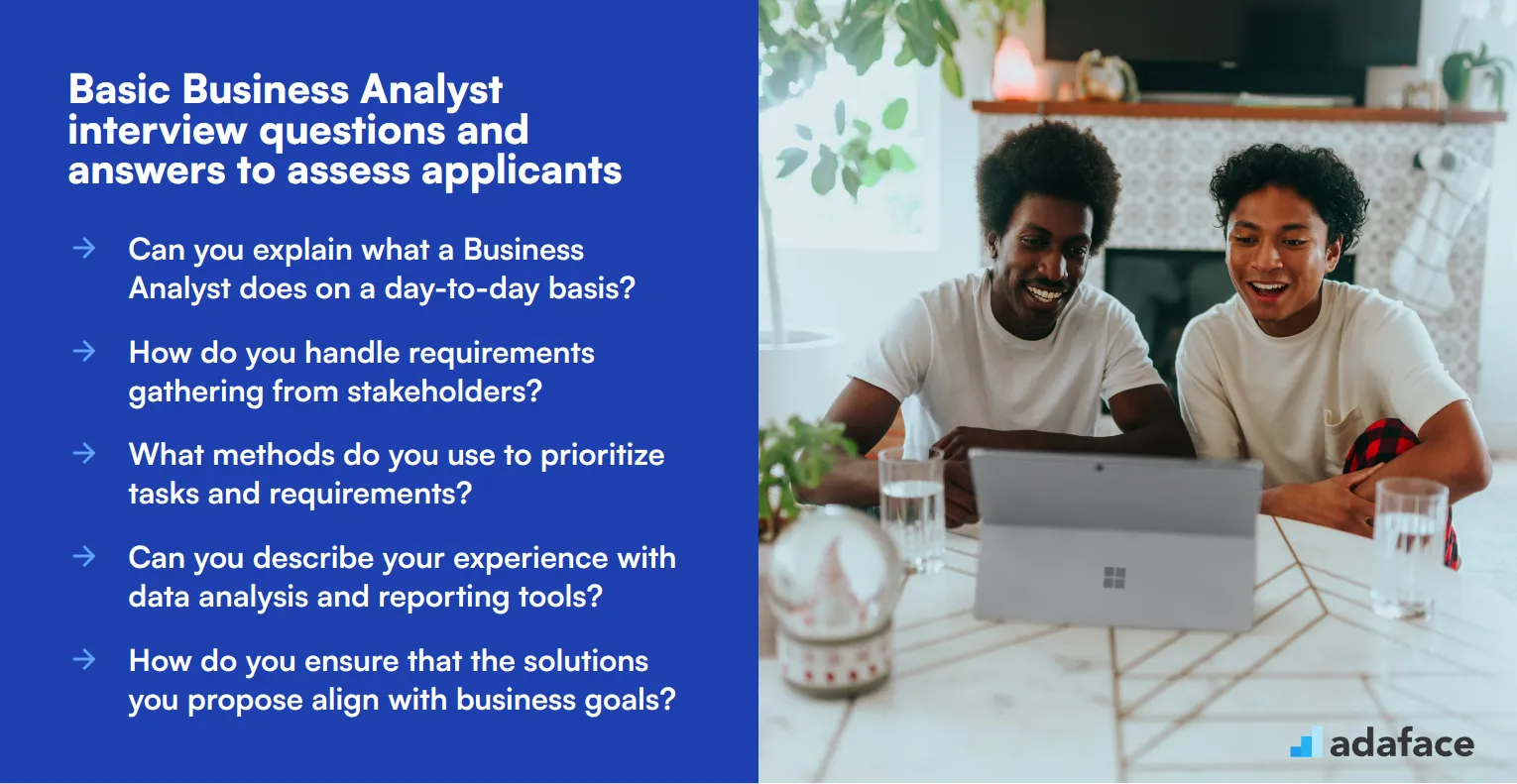
To effectively assess whether your applicants have the right foundational skills and understanding for a Business Analyst role, ask these 10 basic interview questions. These questions are designed to help you gauge their analytical thinking, problem-solving skills, and comprehension of key business concepts.
1. Can you explain what a Business Analyst does on a day-to-day basis?
A Business Analyst (BA) is responsible for bridging the gap between IT and the business using data analytics to assess processes, determine requirements, and deliver data-driven recommendations. They engage with stakeholders to identify business needs and work with IT to implement technology solutions.
Look for candidates who can articulate the key responsibilities of a BA, such as conducting meetings with stakeholders, analyzing data, creating reports, and supporting project management activities. An ideal answer should include a clear understanding of both business operations and IT solutions.
2. How do you handle requirements gathering from stakeholders?
Effective requirements gathering involves communicating with stakeholders through various methods such as interviews, surveys, workshops, and document analysis. The goal is to understand their needs and translate them into detailed, actionable requirements.
Candidates should mention specific techniques they use, like creating user stories or use case diagrams, and emphasize the importance of clear communication. Strong answers will highlight their ability to manage stakeholder expectations and ensure all requirements are thoroughly documented and agreed upon.
3. What methods do you use to prioritize tasks and requirements?
Prioritization can be achieved using frameworks like MoSCoW (Must have, Should have, Could have, Won't have), or by evaluating the impact and urgency of each requirement. Engaging stakeholders in the prioritization process ensures that the most critical needs are addressed first.
Look for candidates who can describe a systematic approach to prioritization and provide examples of how they’ve handled conflicting priorities in the past. Their response should demonstrate an ability to balance short-term needs with long-term goals.
4. Can you describe your experience with data analysis and reporting tools?
Business Analysts often use tools like Excel, SQL, Tableau, or Power BI to analyze data and generate reports. Experience with these tools is crucial for interpreting data trends and making informed business decisions.
Candidates should discuss specific tools they’ve used and the types of analysis they've performed. Ideal responses will include examples of how their data analysis and reporting have led to actionable business insights or process improvements.
5. How do you ensure that the solutions you propose align with business goals?
Aligning solutions with business goals requires a deep understanding of the organization's objectives and strategic direction. This involves constant communication with stakeholders and regular reviews of project goals against business outcomes.
An effective candidate will mention techniques such as SWOT analysis or Balanced Scorecards and stress the importance of continuous feedback loops. Their answer should convey their ability to adapt solutions to evolving business priorities.
6. Describe a challenging project you worked on and how you managed it.
A challenging project might involve tight deadlines, limited resources, or complex stakeholder dynamics. Effective management includes clear communication, meticulous planning, and risk management strategies to mitigate potential issues.
Candidates should provide a specific example, outlining the challenges they faced, the steps they took to address them, and the outcome of the project. Look for responses that show problem-solving skills, resilience, and the ability to lead a team under pressure.
7. How do you handle changes in project scope?
Handling scope changes requires a structured change management process. This often includes assessing the impact of the change, communicating with stakeholders, updating documentation, and adjusting timelines and resources accordingly.
Look for candidates who can describe a formal process for managing scope changes and emphasize the importance of stakeholder buy-in and thorough impact analysis. Their answer should convey their ability to maintain project alignment despite changes.
8. What techniques do you use for process improvement?
Common techniques for process improvement include Lean Six Sigma, BPM (Business Process Management), and root cause analysis. These methods help identify inefficiencies and implement solutions to optimize workflows and increase efficiency.
Candidates should discuss specific techniques they’ve used and provide examples of successful process improvement initiatives. Ideal answers will highlight their analytical skills and their ability to drive continuous improvement.
9. How do you validate and verify the requirements you gather?
Validation and verification involve ensuring that requirements accurately reflect stakeholder needs and are feasible within the project constraints. This often includes techniques such as peer reviews, prototypes, and user acceptance testing (UAT).
An ideal candidate will describe a thorough approach to validation and verification, emphasizing the importance of stakeholder feedback and iterative testing. Look for responses that demonstrate attention to detail and a commitment to delivering high-quality solutions.
10. How do you stay updated with industry trends and best practices?
Staying updated involves continuous learning through industry publications, attending conferences, participating in professional networks, and pursuing relevant certifications. This ensures that Business Analysts can apply the latest methodologies and tools to their work.
Candidates should mention specific resources they use to stay informed, such as industry blogs, webinars, or professional organizations. Their answer should reflect a proactive approach to professional development and a commitment to maintaining relevance in their field.
20 Business Analyst interview questions to ask junior Business Analysts
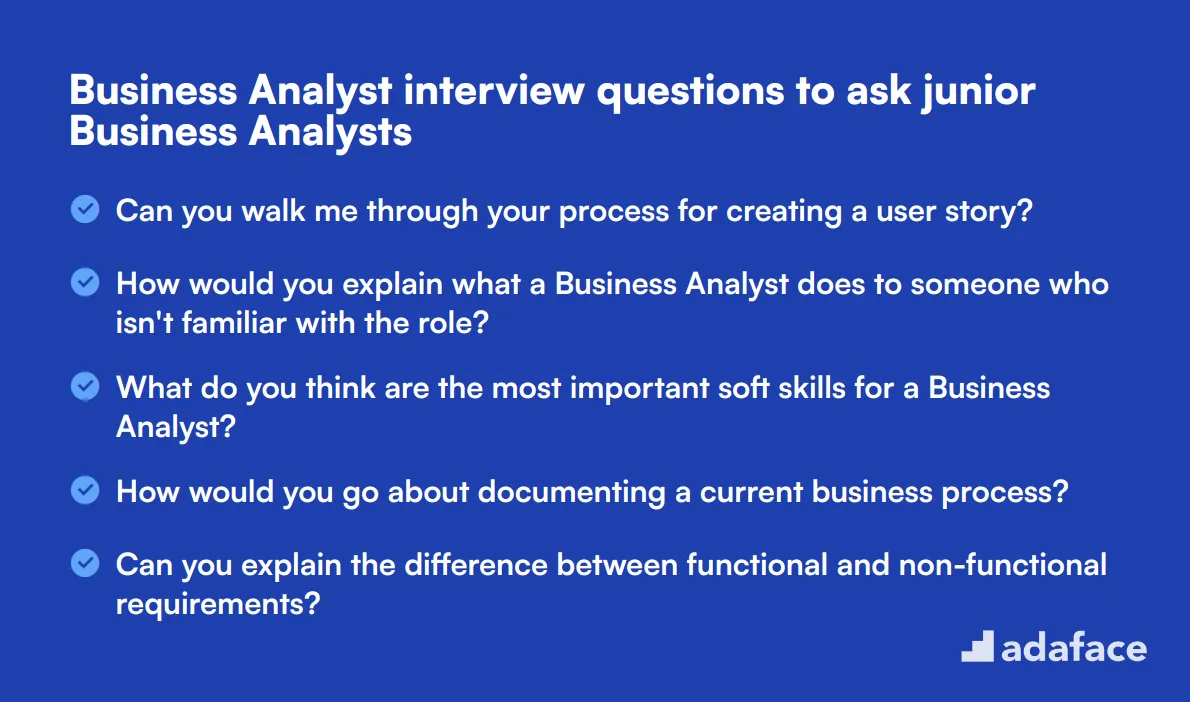
When interviewing junior Business Analysts, it's crucial to assess their foundational skills and potential. The following questions are designed to evaluate a candidate's basic understanding of the role, problem-solving abilities, and communication skills. Use these questions to gauge if the applicant has the right mindset and aptitude for the position.
- Can you walk me through your process for creating a user story?
- How would you explain what a Business Analyst does to someone who isn't familiar with the role?
- What do you think are the most important soft skills for a Business Analyst?
- How would you go about documenting a current business process?
- Can you explain the difference between functional and non-functional requirements?
- How would you handle a situation where stakeholders have conflicting requirements?
- What tools or techniques would you use to create a process flow diagram?
- How do you ensure that you've captured all the necessary requirements for a project?
- Can you explain what BPMN stands for and its purpose?
- How would you approach analyzing and presenting data to non-technical stakeholders?
- What do you understand by the term 'scope creep' and how would you manage it?
- How would you prioritize features if you had limited time and resources?
- Can you explain what a use case is and when you would use one?
- How do you ensure that the requirements you gather are clear and unambiguous?
- What steps would you take to validate that a solution meets the business needs?
- How would you handle a situation where you're given incomplete information for a project?
- Can you explain the purpose of a SWOT analysis in business analysis?
- How would you go about identifying key performance indicators (KPIs) for a project?
- What do you understand by the term 'business rules' and why are they important?
- How would you ensure effective communication between technical and non-technical team members?
8 advanced Business Analyst interview questions and answers to evaluate senior Business Analysts
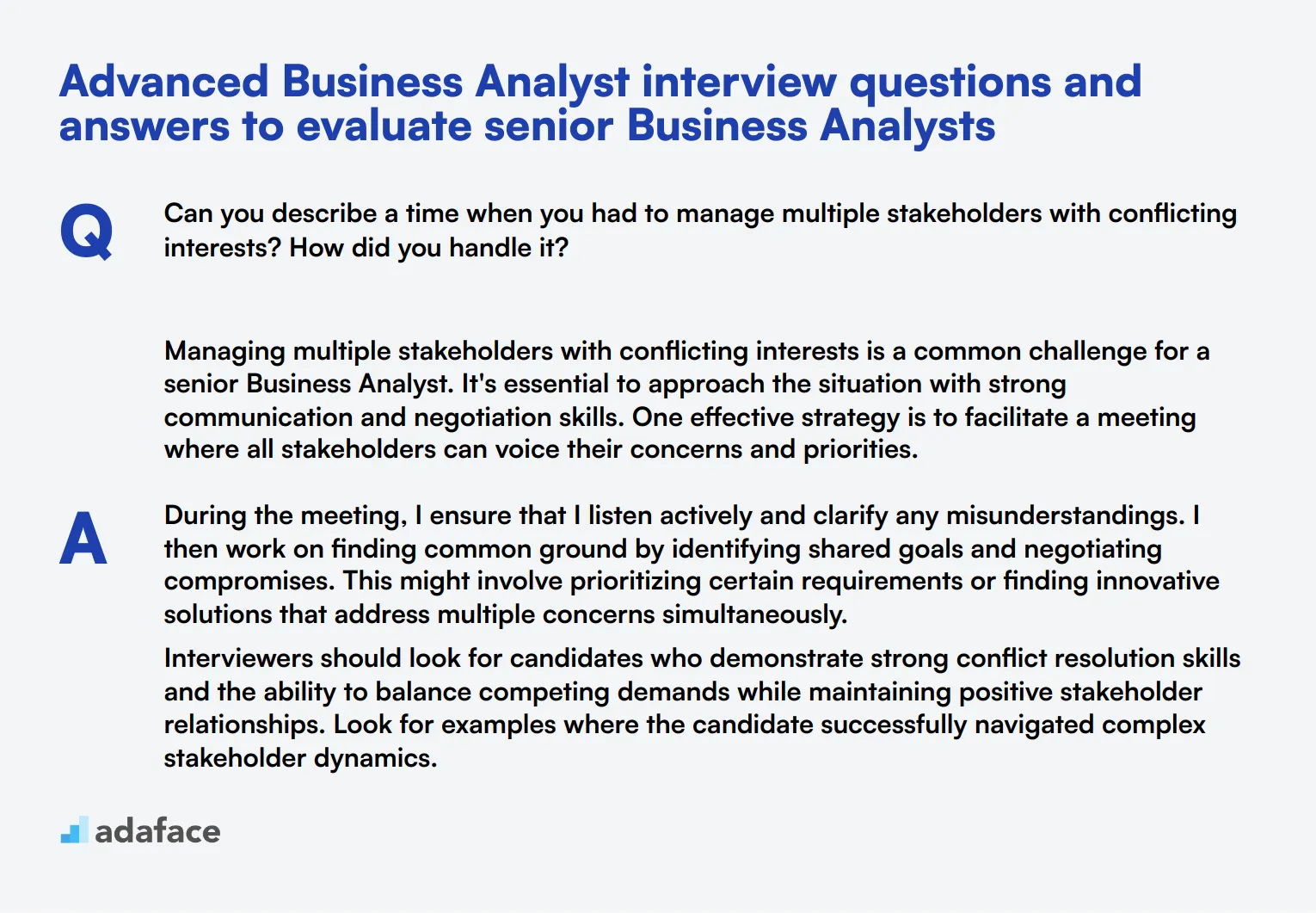
To identify top-tier senior Business Analysts, it's crucial to ask advanced questions that truly test their expertise and experience. These questions will help you gauge their analytical skills, problem-solving abilities, and strategic thinking, ensuring you find the best fit for your team.
1. Can you describe a time when you had to manage multiple stakeholders with conflicting interests? How did you handle it?
Managing multiple stakeholders with conflicting interests is a common challenge for a senior Business Analyst. It's essential to approach the situation with strong communication and negotiation skills. One effective strategy is to facilitate a meeting where all stakeholders can voice their concerns and priorities.
During the meeting, I ensure that I listen actively and clarify any misunderstandings. I then work on finding common ground by identifying shared goals and negotiating compromises. This might involve prioritizing certain requirements or finding innovative solutions that address multiple concerns simultaneously.
Interviewers should look for candidates who demonstrate strong conflict resolution skills and the ability to balance competing demands while maintaining positive stakeholder relationships. Look for examples where the candidate successfully navigated complex stakeholder dynamics.
2. How do you approach developing a business case for a new project or initiative?
Developing a business case involves several key steps. First, I gather relevant data and conduct a thorough analysis of the current situation, including identifying the problem or opportunity. This often involves stakeholder interviews, surveys, and data analysis.
Next, I outline potential solutions, evaluating their feasibility, benefits, and risks. I then perform a cost-benefit analysis to compare the solutions and identify the most viable option. Finally, I compile the findings into a comprehensive business case document, clearly communicating the recommended course of action and its expected impact on the business.
Recruiters should look for candidates who can clearly articulate their process for building a robust business case and who have a track record of successful project justifications. The ideal candidate should demonstrate strong analytical and communication skills.
3. What methods do you use to ensure the quality and accuracy of the data you work with?
Ensuring data quality and accuracy is critical for effective analysis. I start by defining clear data quality standards and validation rules. This includes checking for completeness, consistency, and accuracy through automated tools and manual reviews.
I also collaborate closely with data owners and IT teams to ensure the data sources are reliable and well-maintained. Regular data audits and cleansing activities are part of my routine to identify and rectify any discrepancies. Additionally, I document data lineage to track the data's journey and transformations.
Interviewers should look for candidates who emphasize the importance of data integrity and have practical strategies for maintaining high data quality. Strong candidates will be detail-oriented and proactive in addressing data issues.
4. Can you give an example of how you've used data visualization to drive business decisions?
Data visualization is a powerful tool for communicating insights effectively. In one project, I used data visualization to analyze customer behavior patterns. By creating interactive dashboards and charts, I was able to highlight key trends and anomalies that were not immediately apparent in raw data.
These visualizations helped stakeholders understand the customer journey better and identify areas for improvement. As a result, we implemented targeted marketing strategies that increased customer engagement and retention. The visual tools also facilitated more informed and quicker decision-making processes.
Candidates should demonstrate their ability to translate complex data into clear, actionable insights using visual tools. Look for examples where their visualizations had a tangible impact on business outcomes. For additional context on data visualization skills, you can refer to this data analyst job description.
5. Describe your experience with conducting a gap analysis. What steps do you take, and what tools do you use?
Conducting a gap analysis involves comparing the current state of a process or system with its desired future state. The first step is to clearly define the objectives and identify key performance indicators (KPIs) to measure current performance. I then gather data through interviews, surveys, and document reviews to assess the current state.
Next, I identify gaps by comparing current performance against the desired state. This involves analyzing data, identifying root causes, and prioritizing the gaps based on their impact on business goals. I use various tools such as SWOT analysis, process mapping, and benchmarking to support the analysis.
Interviewers should look for candidates who have a systematic approach to gap analysis and can articulate the steps and tools they use. Strong candidates will have a track record of successfully identifying and addressing gaps to drive improvements.
6. How do you stay updated with the latest trends and technologies in business analysis?
Staying updated with industry trends and technologies is crucial for a Business Analyst. I regularly attend industry conferences, webinars, and workshops to learn from experts and network with peers. I also subscribe to leading industry publications and follow influential thought leaders on social media.
Additionally, I participate in online forums and professional organizations related to business analysis. Continuous learning through online courses and certifications also helps me stay current with new methodologies and tools. This proactive approach ensures that I can bring fresh perspectives and best practices to my role.
Candidates should demonstrate a commitment to continuous learning and professional development. Look for examples of how they apply new knowledge to their work and stay ahead of industry changes. For more on essential skills, you can check this business analyst skills guide.
7. What strategies do you use to elicit requirements from stakeholders who are unsure of what they need?
Eliciting requirements from stakeholders who are unsure of what they need requires a combination of techniques. I start by building rapport and asking open-ended questions to understand their pain points and objectives. Techniques like brainstorming sessions, workshops, and focus groups can help stakeholders articulate their needs.
I also use visual aids such as process flow diagrams, mockups, and prototypes to facilitate discussions and clarify requirements. Regularly validating and refining the requirements through iterative feedback loops ensures that the final requirements are well-defined and aligned with business goals.
Recruiters should look for candidates who can effectively use various requirement elicitation techniques and demonstrate strong communication and facilitation skills. The ideal candidate will be adept at guiding stakeholders towards clarity and consensus.
8. How do you handle a situation where your proposed solution is met with resistance from the team?
When facing resistance to a proposed solution, it's important to understand the root cause of the resistance. I start by engaging in open and empathetic communication with the team members to understand their concerns and reservations. This helps in identifying any misunderstandings or valid objections.
I then address these concerns by providing additional information, evidence, or alternative options. In some cases, involving the team in the decision-making process and demonstrating the benefits of the proposed solution through pilot tests or simulations can help gain their buy-in. Building trust and demonstrating flexibility are key to overcoming resistance.
Interviewers should look for candidates who show resilience and adaptability in the face of opposition. Strong candidates will have examples of successfully navigating resistance and fostering collaboration and acceptance among team members.
12 Business Analyst questions related to processes and methodologies
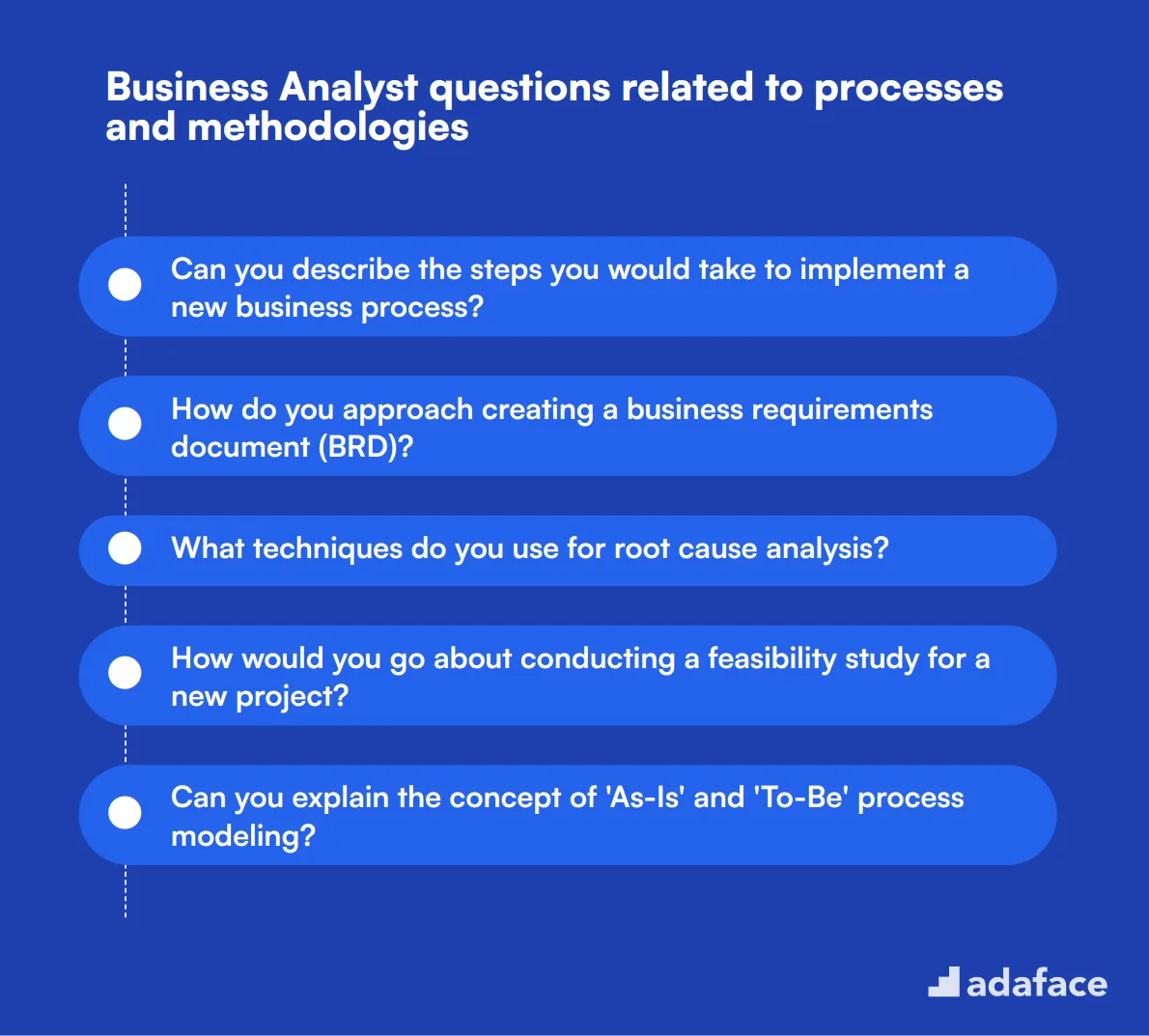
To assess a candidate's understanding of business analysis processes and methodologies, consider using these insightful questions. They'll help you gauge the applicant's practical knowledge and problem-solving approach in real-world scenarios.
- Can you describe the steps you would take to implement a new business process?
- How do you approach creating a business requirements document (BRD)?
- What techniques do you use for root cause analysis?
- How would you go about conducting a feasibility study for a new project?
- Can you explain the concept of 'As-Is' and 'To-Be' process modeling?
- What's your experience with Agile methodologies in business analysis?
- How do you approach creating a business process model?
- Can you describe your method for conducting a cost-benefit analysis?
- What strategies do you use for stakeholder management?
- How do you approach risk assessment in a project?
- Can you explain the purpose and process of creating a traceability matrix?
- How do you ensure alignment between business requirements and IT solutions?
9 Business Analyst interview questions and answers related to stakeholder management
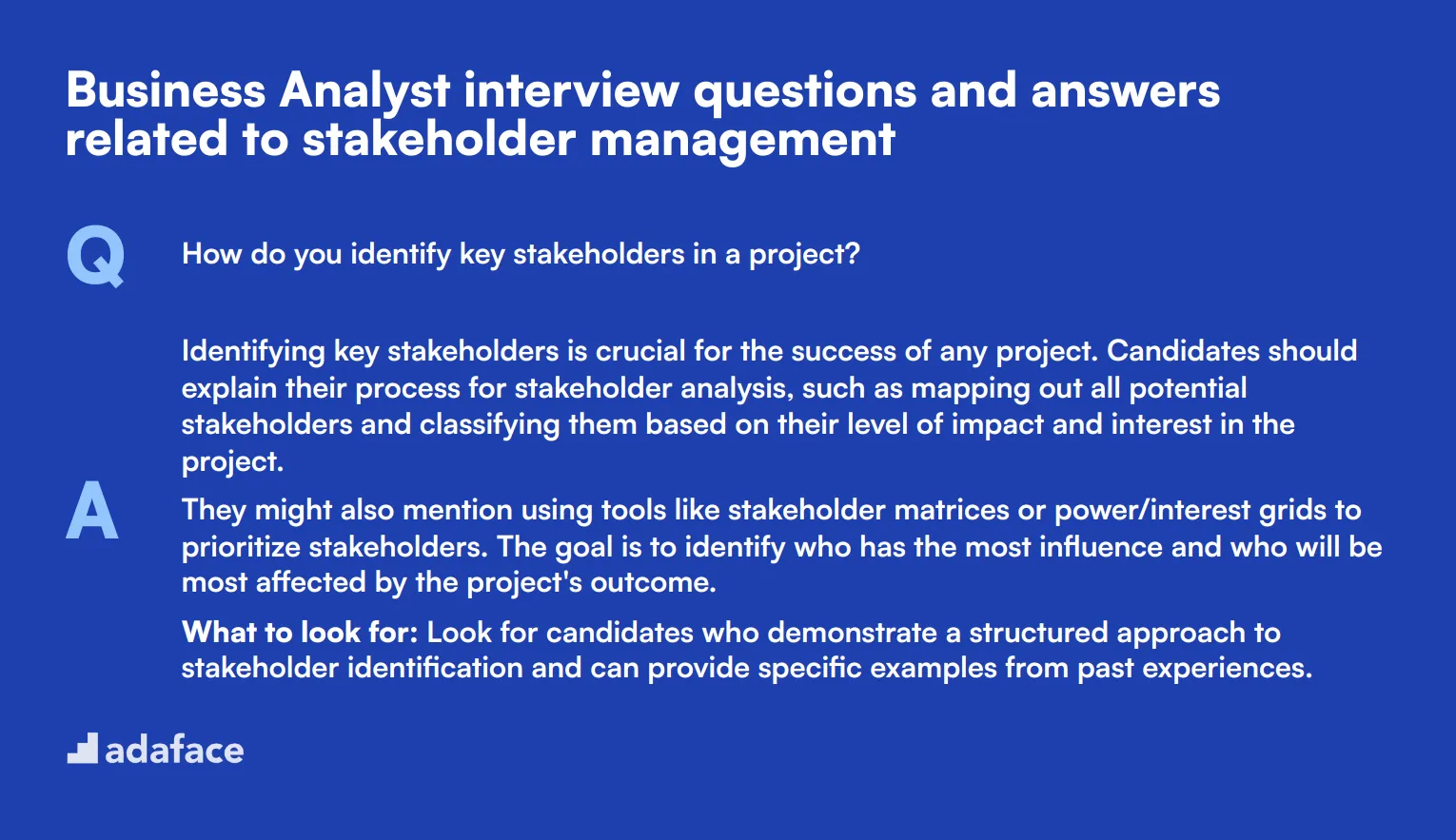
Understanding how candidates manage stakeholders can make or break a project’s success. Use these questions to gauge their skills and strategies in stakeholder management, ensuring they can handle the intricate web of relationships that come with the role.
1. How do you identify key stakeholders in a project?
Identifying key stakeholders is crucial for the success of any project. Candidates should explain their process for stakeholder analysis, such as mapping out all potential stakeholders and classifying them based on their level of impact and interest in the project.
They might also mention using tools like stakeholder matrices or power/interest grids to prioritize stakeholders. The goal is to identify who has the most influence and who will be most affected by the project's outcome.
What to look for: Look for candidates who demonstrate a structured approach to stakeholder identification and can provide specific examples from past experiences.
2. Can you describe a time when you had to manage conflicting interests among stakeholders?
Managing conflicting interests among stakeholders is a common challenge for Business Analysts. A strong candidate will describe a specific situation where they navigated conflicting demands, outlining the steps they took to mediate and find a compromise.
They might highlight skills such as active listening, negotiation, and transparent communication. Effective conflict resolution often involves finding common ground and focusing on the project’s overall goals.
What to look for: Look for evidence of problem-solving skills and the ability to maintain positive relationships even when conflicts arise. Ask for follow-up details on the outcomes and any lessons learned.
3. How do you ensure effective communication with stakeholders throughout the project?
Effective communication is key to stakeholder management. Candidates should discuss their strategies for keeping stakeholders informed and engaged, such as regular meetings, status reports, and using collaboration tools.
They might also mention tailoring their communication style to suit different stakeholders, ensuring that technical details are explained clearly to non-technical stakeholders.
What to look for: Look for candidates who emphasize the importance of transparency and consistency in communication. They should also demonstrate flexibility in adapting their communication methods to meet the needs of different stakeholders.
4. What techniques do you use to gather feedback from stakeholders?
Gathering feedback from stakeholders is essential for continuous improvement. Candidates should describe a variety of techniques they use, such as surveys, interviews, and focus groups, to collect feedback effectively.
They might also discuss the importance of creating a comfortable environment where stakeholders feel their input is valued and can be given honestly.
What to look for: Look for candidates who show a proactive approach to seeking feedback and can provide examples of how they have used stakeholder feedback to improve project outcomes.
5. How do you handle a situation where a stakeholder is not engaged or responsive?
Non-engaged stakeholders can pose significant risks to a project. Candidates should explain their strategies for re-engaging stakeholders, such as identifying the root cause of their disengagement and addressing it directly.
They might also discuss the importance of building trust and demonstrating how the project benefits the stakeholder, thus motivating them to participate.
What to look for: Look for candidates who can provide specific examples of how they successfully re-engaged stakeholders and the impact it had on the project. Their answers should reflect a combination of empathy and strategic thinking.
6. How do you balance the needs and priorities of multiple stakeholders?
Balancing multiple stakeholders' needs requires careful prioritization and negotiation. Candidates should describe their methods for understanding and ranking stakeholder needs, such as using a prioritization matrix or conducting cost-benefit analyses.
They might also highlight the importance of transparent communication and setting clear expectations with all stakeholders to manage priorities effectively.
What to look for: Look for candidates who demonstrate strong organizational skills and the ability to make strategic decisions that align with the overall project goals. Ask for examples of how they have effectively managed competing priorities in the past.
7. Can you provide an example of how you have managed stakeholder expectations?
Managing stakeholder expectations is vital for maintaining trust and project alignment. A strong candidate will provide a specific example where they set and managed expectations through clear communication and regular updates.
They might also discuss how they handled any changes or setbacks and kept stakeholders informed and reassured throughout the process.
What to look for: Look for candidates who show a proactive approach to expectation management and can provide examples of successful outcomes. Their answers should reflect their ability to maintain positive relationships under various circumstances.
8. How do you ensure that stakeholder requirements are accurately captured and documented?
Accurately capturing and documenting stakeholder requirements is crucial for project success. Candidates should describe their process for gathering requirements, such as conducting interviews, workshops, and using requirement elicitation techniques like user stories or use cases.
They might also discuss the importance of validating and verifying requirements with stakeholders to ensure accuracy and completeness.
What to look for: Look for candidates who demonstrate a thorough and structured approach to requirement gathering and documentation. They should emphasize the importance of ongoing communication with stakeholders to avoid misunderstandings and ensure alignment.
9. How do you manage stakeholder involvement throughout the project lifecycle?
Managing stakeholder involvement throughout the project lifecycle requires continuous engagement and communication. Candidates should describe their strategies for keeping stakeholders involved, such as regular check-ins, progress reports, and involving them in key decision-making processes.
They might also highlight the importance of flexibility in accommodating stakeholder input and making adjustments as needed to ensure project success.
What to look for: Look for candidates who show a commitment to maintaining strong relationships with stakeholders throughout the project. They should provide examples of how their approach has led to successful project outcomes and stakeholder satisfaction.
7 situational Business Analyst interview questions with answers for hiring top Business Analysts
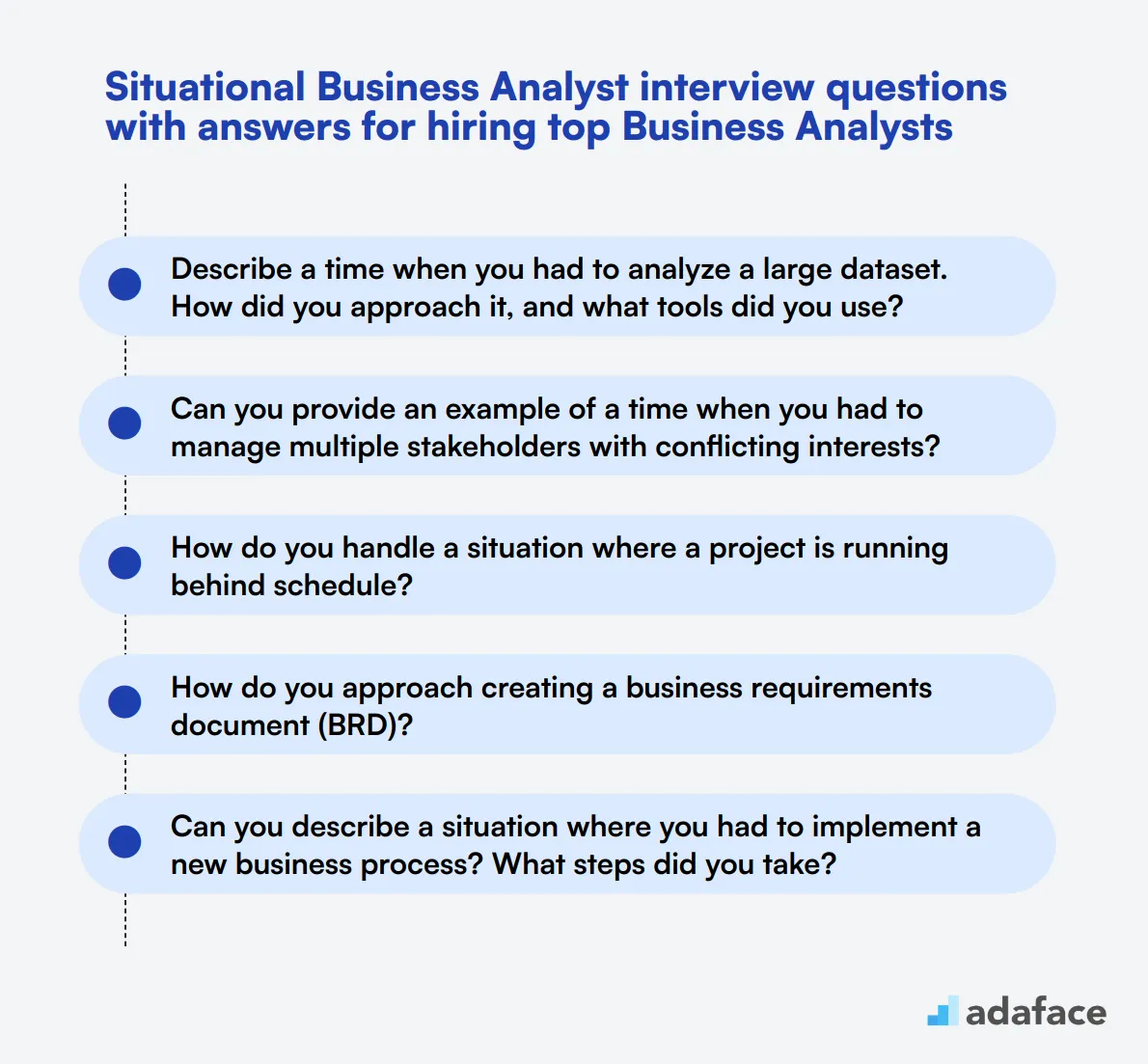
Hiring a stellar Business Analyst can be a game-changer for your organization. To help you sift through the talent pool and find the best fit, we've compiled a list of situational interview questions tailored to assess candidates' practical skills and problem-solving abilities. Use these questions to see how they handle real-world scenarios and make data-driven decisions.
1. Describe a time when you had to analyze a large dataset. How did you approach it, and what tools did you use?
When faced with a large dataset, I usually start by defining the objectives and key questions I need to answer. This helps me focus on relevant data points and avoid getting overwhelmed. Next, I clean the data to ensure accuracy by removing any duplicates or errors.
I typically use tools like Excel for initial data cleaning and visualization. For more complex analysis, I turn to SQL or Python to perform more detailed queries and analytics. These tools help me uncover patterns and insights that can inform business decisions.
Ideal candidates should demonstrate a methodical approach to data analysis and proficiency with relevant tools. Look for examples of how they have successfully used these tools in previous roles and how their analysis impacted business outcomes.
2. Can you provide an example of a time when you had to manage multiple stakeholders with conflicting interests?
In a previous project, I was responsible for gathering requirements from various departments, each with its own priorities and concerns. I started by organizing a series of workshops to understand each stakeholder's needs and expectations.
To manage conflicting interests, I facilitated open discussions and encouraged stakeholders to prioritize their requirements collaboratively. I also created a requirements traceability matrix to ensure transparency and keep everyone aligned on project goals.
Look for candidates who showcase strong communication and negotiation skills. They should be able to provide specific examples of how they balanced conflicting interests and achieved a consensus.
3. How do you handle a situation where a project is running behind schedule?
When a project is running behind schedule, my first step is to identify the root cause. I review the project plan, milestones, and timelines to pinpoint where delays are occurring. This helps me understand if the issue is due to resource constraints, scope changes, or other factors.
I then reassess the project plan and collaborate with the team to reallocate resources or adjust timelines as needed. Communication with stakeholders is crucial during this time to manage expectations and keep them informed of any changes.
The ideal response should reflect proactive problem-solving and effective communication skills. Candidates should demonstrate their ability to adapt and implement corrective actions to get the project back on track.
4. How do you approach creating a business requirements document (BRD)?
Creating a BRD starts with thorough stakeholder interviews to gather all necessary information and requirements. I ensure that I understand the business objectives, project scope, and any constraints or assumptions.
I then organize the requirements into a structured format, detailing functional and non-functional requirements, and include diagrams or models if needed. This helps in visualizing the requirements and ensuring nothing is overlooked.
Look for candidates who emphasize the importance of clear, concise documentation and stakeholder involvement. They should be able to explain their method for ensuring that the BRD accurately reflects the project's needs and goals.
5. Can you describe a situation where you had to implement a new business process? What steps did you take?
When implementing a new business process, I start by conducting a thorough analysis of the existing process to identify areas of improvement. This involves gathering data, interviewing key stakeholders, and mapping out the current process flow.
Next, I design the new process, ensuring it aligns with business goals and addresses the identified inefficiencies. I create detailed process documentation and provide training to the team to ensure a smooth transition.
Strong candidates should demonstrate a systematic approach to process improvement and highlight their ability to engage stakeholders throughout the implementation. Look for examples of how their efforts led to measurable improvements in efficiency or productivity.
6. How do you approach risk assessment in a project?
Risk assessment begins with identifying potential risks that could impact the project. I typically use brainstorming sessions with the project team and stakeholders to uncover as many risks as possible.
I then evaluate each risk based on its likelihood and impact, using a risk matrix to prioritize them. For high-priority risks, I develop mitigation plans and contingency strategies to minimize their potential impact on the project.
An effective response should highlight the candidate's proactive approach to risk management and their ability to collaborate with the team. Look for specific examples of how they successfully identified and mitigated risks in previous projects.
7. Describe your experience with conducting a gap analysis. What steps do you take, and what tools do you use?
Conducting a gap analysis involves identifying the current state of a process or system and comparing it to the desired future state. I start by gathering baseline data through observations, interviews, and reviewing existing documentation.
I then analyze the data to identify gaps, such as inefficiencies or missing capabilities. Tools like process mapping software or basic spreadsheets can be instrumental in visualizing these gaps and developing a clear action plan to address them.
Look for candidates who can articulate a structured approach to gap analysis and provide examples of how their analysis led to process improvements. They should be comfortable using various tools and have a keen eye for detail.
10 behavioral Business Analyst interview questions
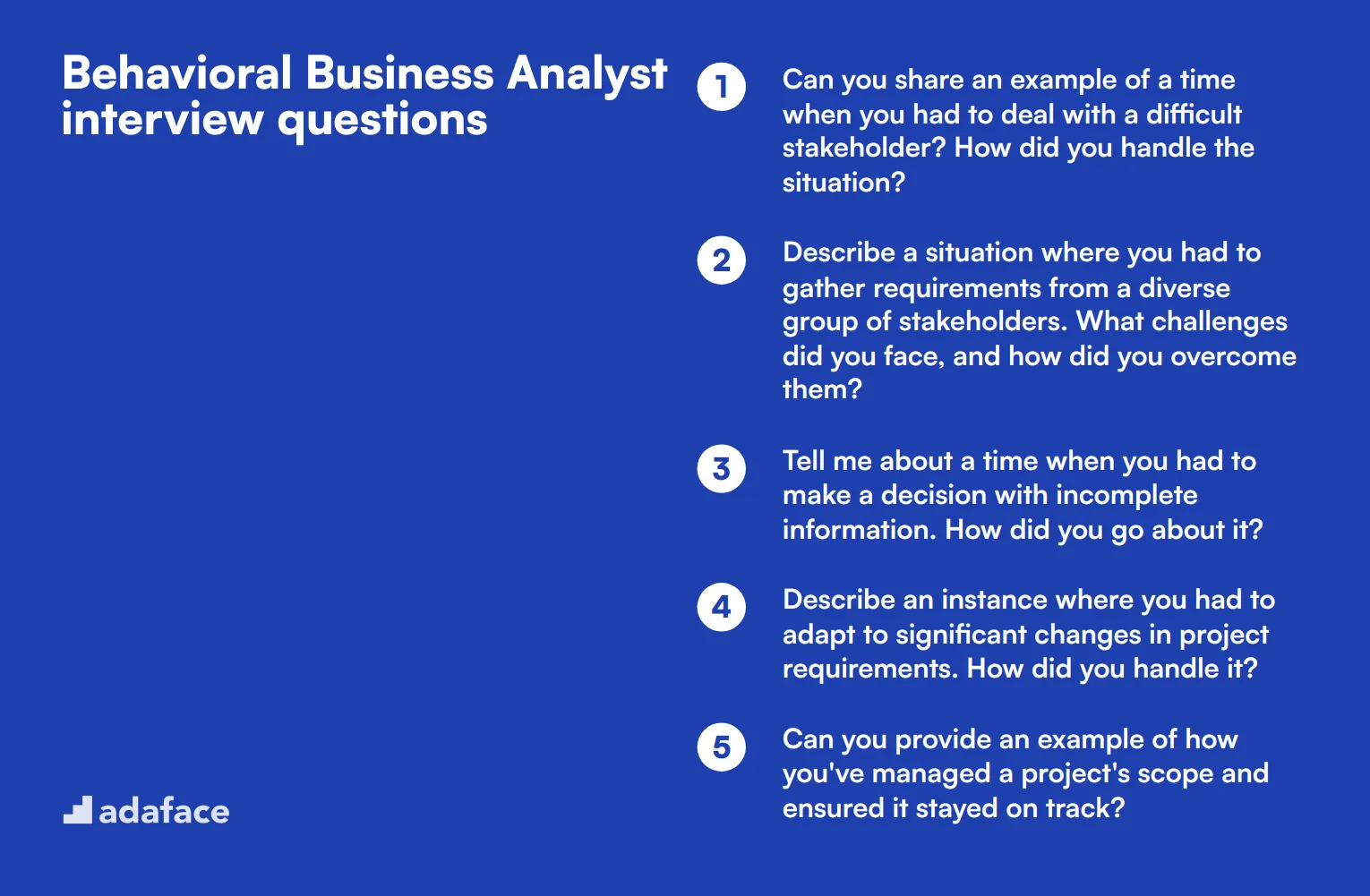
To determine whether your applicants have the right skills for the role of a Business Analyst, using a list of behavioral interview questions can be extremely beneficial. These questions help you gain insights into how candidates handle real-world situations and challenges, ensuring they have the practical experience needed for the job. For a more detailed job description, you can refer to relevant resources.
- Can you share an example of a time when you had to deal with a difficult stakeholder? How did you handle the situation?
- Describe a situation where you had to gather requirements from a diverse group of stakeholders. What challenges did you face, and how did you overcome them?
- Tell me about a time when you had to make a decision with incomplete information. How did you go about it?
- Describe an instance where you had to adapt to significant changes in project requirements. How did you handle it?
- Can you provide an example of how you've managed a project's scope and ensured it stayed on track?
- Describe a situation where you had to influence a team or stakeholder without having direct authority. How did you achieve your goals?
- Tell me about a time when you identified a process inefficiency. What steps did you take to improve it?
- Can you share an experience where you had to present complex data or a solution to a non-technical audience? How did you ensure they understood you?
- Describe a scenario where you had to collaborate with a cross-functional team. What was your approach, and what challenges did you encounter?
- Tell me about a time when you had to prioritize multiple high-priority tasks. How did you manage your time and ensure deadlines were met?
Which Business Analyst skills should you evaluate during the interview phase?
Evaluating a Business Analyst's skills can be challenging since a single interview may not reveal everything about a candidate's capabilities. However, there are core skills that are pivotal in determining whether a candidate is a good fit for the role. In this section, we will explore these essential skills and how to assess them effectively during the interview phase.
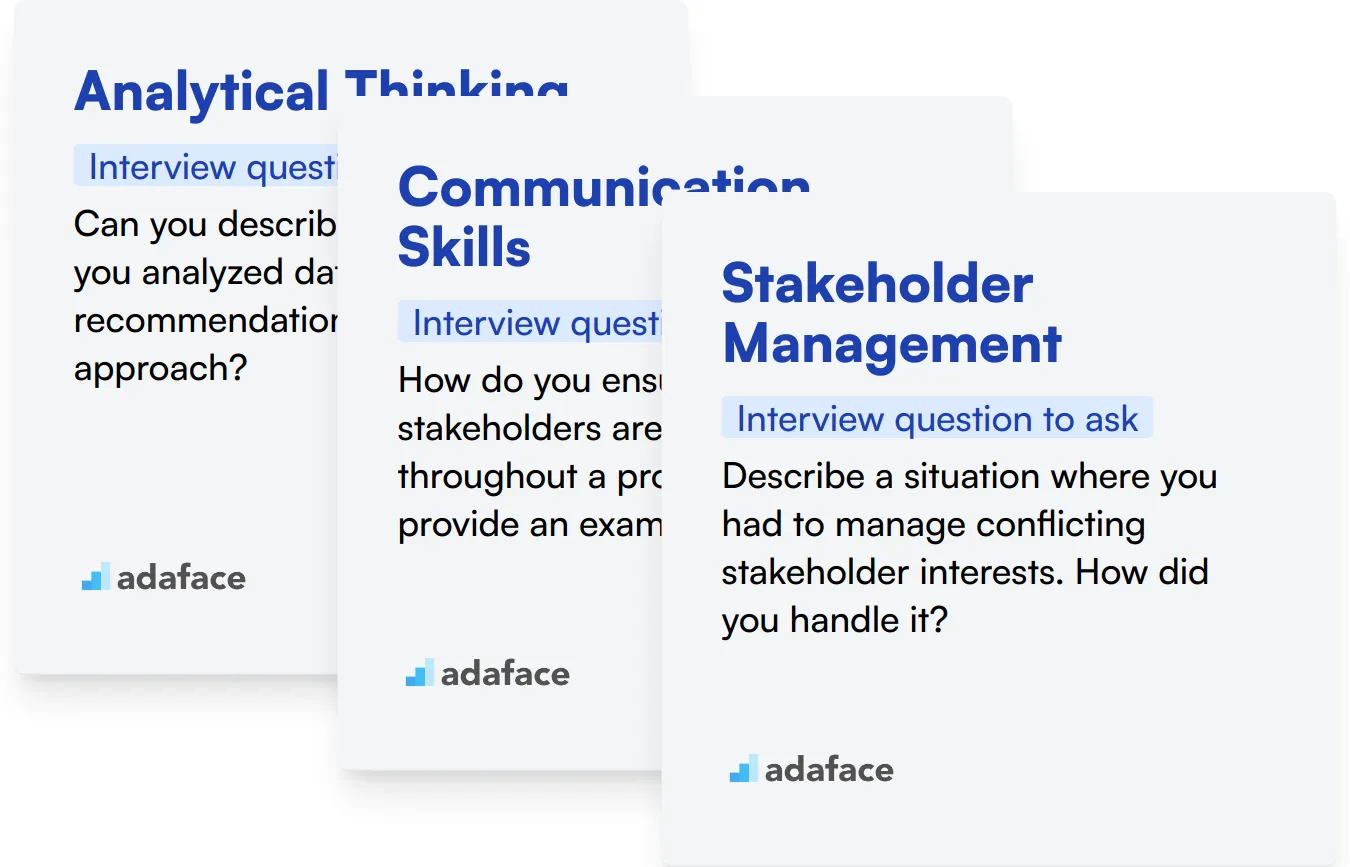
Analytical Thinking
To filter candidates based on their analytical thinking skills, consider using an assessment test that includes relevant multiple-choice questions. Our Data Analysis Test in the library can help you evaluate this skill effectively.
Additionally, you can pose targeted interview questions to gauge their analytical thinking ability. Here's one such question:
Can you describe a time when you analyzed data to make a recommendation? What was your approach?
When asking this question, look for clarity in their thought process and the methods they used to analyze the data. A strong candidate should demonstrate a structured approach to problem-solving and articulate how their analysis impacted the decision-making process.
Communication Skills
You can assess communication skills through a targeted assessment test with relevant MCQs. While we don't have a specific test for this skill in our library, it's important to create an environment where candidates can showcase their abilities.
To evaluate this skill in the interview, consider asking the following question:
How do you ensure that stakeholders are kept informed throughout a project? Can you provide an example?
Listen for their strategies in keeping stakeholders updated and how they tailor their communication style to different audiences. A strong answer should reflect their ability to adapt and maintain open lines of communication.
Stakeholder Management
While there isn't a direct assessment test for stakeholder management in our library, consider using situational-based questions during the interview to evaluate this skill.
One key question you might ask is:
Describe a situation where you had to manage conflicting stakeholder interests. How did you handle it?
Pay attention to how the candidate articulates their approach to resolving conflicts and balancing different interests. A strong candidate will demonstrate negotiation skills and the ability to find common ground.
Tips for Effective Business Analyst Interview Questions
Before putting your newly acquired knowledge to use, consider these tips to enhance your Business Analyst interview process.
1. Implement Skills Tests Before Interviews
Skills tests provide an objective measure of a candidate's abilities before the interview stage. They help filter out unqualified candidates and focus your time on the most promising applicants.
For Business Analysts, consider using tests that evaluate analytical skills, problem-solving abilities, and data interpretation. The Business Analyst Assessment Test can be a good starting point.
Implement these tests after initial resume screening but before interviews. This approach saves time and ensures you're interviewing candidates with the necessary technical skills for the role.
2. Prepare a Balanced Set of Interview Questions
Time is limited during interviews, so it's crucial to ask the right questions. Focus on a mix of technical, behavioral, and situational questions to get a well-rounded view of the candidate.
Include questions that assess the candidate's experience with stakeholder management, process improvement, and requirements gathering. These are key aspects of a Business Analyst's role.
Consider incorporating questions from related fields such as project management or data analysis to evaluate the candidate's broader skill set and adaptability.
3. Master the Art of Follow-Up Questions
Asking follow-up questions is crucial to dig deeper into a candidate's responses and assess their true capabilities. It helps you distinguish between candidates who have memorized answers and those with genuine experience and understanding.
For example, if a candidate mentions using a specific tool for data analysis, ask them to describe a challenging project where they used it. This follow-up can reveal their problem-solving approach and depth of knowledge.
Use Business Analyst interview questions and skills tests to hire talented Business Analysts
If you want to hire someone with strong Business Analyst skills, it's important to ensure they possess those skills accurately. The most effective way to do this is by using skill tests, such as our Business Analyst Assessment Test.
After implementing this test, you'll be able to shortlist the best applicants and invite them for interviews. To get started, you can sign up here or explore our online assessment platform for more options.
Business Analyst Aptitude Online Test
Download Business Analyst interview questions template in multiple formats
Business Analyst Interview Questions FAQs
The list covers basic, junior, senior, process-related, stakeholder management, situational, and behavioral questions for Business Analysts.
There are 20 interview questions specifically tailored for junior Business Analysts in this comprehensive list.
Yes, the list includes 8 advanced questions designed to assess the skills and experience of senior Business Analysts.
Absolutely. There are 7 situational interview questions with answers to help evaluate how candidates might handle real-world scenarios.
Yes, the post includes a section with tips for asking effective Business Analyst interview questions to get the most out of your interviews.

40 min skill tests.
No trick questions.
Accurate shortlisting.
We make it easy for you to find the best candidates in your pipeline with a 40 min skills test.
Try for freeRelated posts
Free resources




